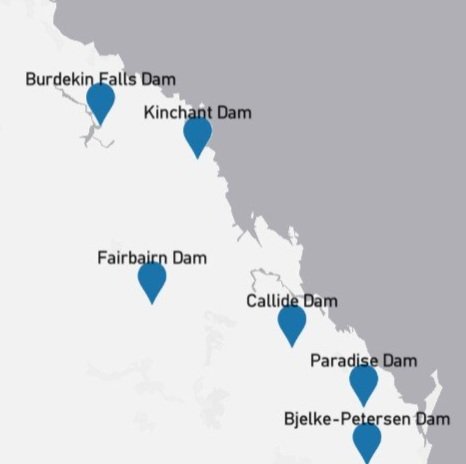Sunwater - Paradise Dam Improvement Project & Burdekin Falls Improvement Project
Scope: Develop Australian Industry Participation Plans
Industry: Mining and Government
Project Cost: $13.7 Billion
Sunwater has a proud 80-year history of developing and managing over $13.7 billion in bulk water infrastructure assets, which supplies 40 percent of all water used commercially in Queensland. As part of their longer-term investment strategy, in 2022, Sunwater announced plans to upgrade two major dam facilities in regional Queensland – Paradise Dam in the Wide Bay-Burnett Region and Burdekin Falls Dam in North Queensland.
10 Functional Areas with Requirements
2 Concurrent AIP Plans delivered
Overview
In October 2022, during the early planning phases, Hughes et al (HEA) were engaged through a competitive tender process to develop individual Australian Industry Participation Plans (AIP Plan) for two individual projects. The separately titled Paradise Dam Improvement Project (PDIP) and the Burdekin Falls Improvement Project (BFIP).
As both projects were estimated to be over $500 million, Sunwater was required to have a compliant AIP Plan for both PDIP and BFIP. An AIP Plan is a one of the foundation stones of good local content practice and is a requirement under the Australian Jobs Act 2013 (Cth). A standalone document, the AIP Plan contains information on how the project’s local content strategy will provide “full, fair and reasonable” opportunities for Australian industry to bid for the supply of goods and/or services, including labour.
While both projects had similarities in engineering and constructability, they remained two standalone projects, operating in different regional contexts, with their own Sunwater project delivery team. In order to deliver the scope, HEA collaborated with each team, undertaking two separate planning processes in parallel, with the output being two separate AIP Plans prepared for submission.
The development of an AIP Plan requires input from multiple functions, including Engineering, Contracts, Procurement, Construction, Human Resources, Environmental, Legal, Project Management, Stakeholder Engagement and Communications. In developing the two AIP Plans for Sunwater, HEA had to collect input from over 18 individual stakeholders across the project.
As experts in the development of AIP Plans of this nature, HEA has developed a well-practiced and efficient process that supports the information collection needed to complete a detailed, compliant and meaningful AIP Plan.
Through a number of virtual meetings, workshops and shared technology platforms, HEA were able to collaborate with the various key Sunwater stakeholders to deliver a total of 6 workshops, 2 feedback sessions and bronze to gold documentation creation and review.
-
When structured correctly, the AIP Planning process can be a valuable point of collaboration in bringing functions together.
Workshops are a great tool to foster collaboration and maximise client input when there are strict timeframes around delivery.
The importance of ensuring that there is a dedicated engineering review of the asset because similar projects have specific requirements.
Engagement with the Australian Industry Participation Authority (AIPA) is an important collaborative step in the development of an AIP Plan.
-
When considering the challenges in any AIP Plan development, one that the HEA team often encounters is a natural hesitancy to publicly release
information at such an early stage of the project. By definition, an AIP Plan is required a matter of years ahead of when the actual project reaches financial close so it’s understandable that caution should be exercised in the publishing of procurement requirements and commitments. Often the AIP Plan is one of only a few public documents available, from which the broader community can make assessments of the project’s intent regarding local content.
Fortunately, with both the PDIP and BDIP projects, the relatively uncomplex requirements for dam procurement coupled with well planned projects and an existing public narrative through their Community and Stakeholder team meant that whilst checks and balances were still required, the ability to have information published was a useful trait for Sunwater to have.
The primary challenge for the HEA team was to develop two AIP Plans that were detailed enough to demonstrate the depth of opportunity available to local industry, while also developed and submitted in an efficient manner to ensure compliance with the Australian Industry Participation Authority.
Developing the AIP Plans specifically for both the PDIP and the BDIP projects with tight timeframes in place for AIP Plan development and submission was due to the impending commencement of an Early Contractor Involvement (ECI) process, and associated early works packages.
The team at HEA were able to provide advice on how these requirements align with AIP Plan obligations and clarified likely operational impact, risk and opportunities of the project adopting AIP Plan requirements. The Sunwater team were also very keen on ensuring AIP Plan alignment with the Queensland Procurement Policy (QPP) and the associated Best Practice Principles (BPP) was also recognised.
While ensuring deadlines were met, for each AIP Plan HEA undertook the following steps:
Hosted a project kick off meeting with all stakeholders.
Established a project plan and provided a project calendar and schedule of milestones and engagement.
Undertook a detailed read-in of Sunwater supplied documents relating to the project including technical documentation.
Undertook a procurement package contestability workshop and AIP Plan unbundling exercise.
Authored an AIP Plan notification and issued for feedback and participant input.
Authored the Draft AIP Plan submission and issued for workshopping and internal functional input.
Facilitated a virtual Draft AIP Plan review workshops and answered questions and comments.
Updated finally drafted AIP Plans and provide submission support and guidance.
Issued Pre and Post workshop surveys to track AIP Plan development and standards understanding
-
A successful ecosystem is one built on open and transparent communication, a consistent improvement of practices and approaches and a system framework within which to work.
As previously mentioned, the first step in collaborating with Sunwater was the establishment of HEA’s Basecamp project management system. Basecamp works because it provides a simple and easily accessible place for everyone, in every role, to store, work on, discuss, decide and deliver the stuff that makes up every project. All project information, tasks, events, documents and communication are intuitively stored and organised in one centralised place where everyone can work together, rather than on separate platforms scattered in various places.
To compliment the Basecamp system, a private SharePoint cloud server for Sunwater and HEA teams to access was also established to make sharing of early research, formal Business Cases and other project specific documentation and revisions of Plans easier.
AIP Plans themselves exist within their own ecosystem that aligns under the Australian Industry Participation National Framework that is overseen by the Australian Industry Participation Authority. Improving standards of AIP Plan development and submission is a crucial element in any local content strategy. Knowledge of this system is vital to the development, submission and approval of any AIP Plan and HEA have the experience to assist.
-
With 15 years’ experience in local industry engagement, the HEA team understand that early engagement and definition of AIP Plan obligations and expectations is essential in ensuring successful development. The cornerstone of any successful Plan development is collaboration and to that end, the HEA team adopted a collaborative delivery framework from the start of our engagement.
The first step in collaborating was the establishment of shared systems with working environments established in the Sunwater SharePoint and HEA Basecamp and SharePoint. The time bound activities looked for economies of efficiency that were similar across both AIP Plans, to ensure HEA would be maximising the Sunwater's time for meetings, input and feedback more effectively.
From here, HEA executed the first of several team workshops with the individual project delivery teams, focusing on each project specific needs and constraints. The workshops were vital for fostering collaboration, sharing ideas, identifying risks and opportunities and providing a forum where all team members could make a contribution. They were also a great way to ensure the project kept to the strict development and submission timeframes and for individual and team responsibilities and commitments to be assigned.
The workshops also provided the HEA team with a forum to initiate thoughts amongst the Sunwater project delivery teams regarding how they propose to engage the local market. This included the recommendation to engage ICN Queensland to utilise the ICN Gateway, in addition to building on the established engagement of suppliers by the Community and Stakeholder team.
While the AIP Plan development process didn’t require any specific collaborations with industry groups, Sunwater had already established an external Working Group for each project and HEA was able to research these groups to get a better understand how an AIP Plan could be further developed to meet their expectations and requirements moving forward.




